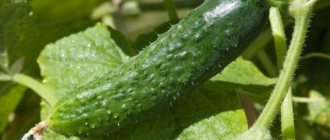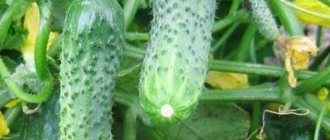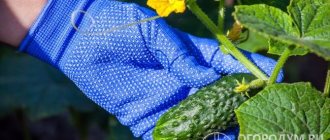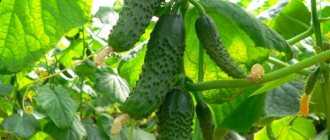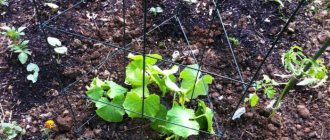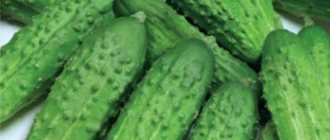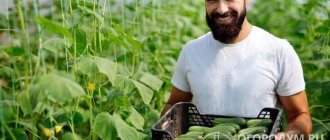Have you ever heard of sprint vegetables? Believe me, there are such people. Among cucumbers, this is a hybrid Bouquet. It is characterized by bouquet fruiting and rapid yield of most of the harvest, literally within a month. This amazing variety was developed by breeders of Selection and Seed Production LLC. An application for registration of the new product was submitted in 2004, and the variety was included in the State Register of Breeding Achievements of Russia in 2008. Received approval in all regions and a recommendation for cultivation in open ground and under film covers in private farms. Belonging to a hybrid is confirmed by the mandatory F1 marking.
Cucumber variety Bouquet (F1)
Have you ever heard of sprint vegetables? Believe me, there are such people. Among cucumbers, this is a hybrid Bouquet. It is characterized by bouquet fruiting and rapid yield of most of the harvest, literally within a month. This amazing variety was developed by breeders of Selection and Seed Production LLC. An application for registration of the new product was submitted in 2004, and the variety was included in the State Register of Breeding Achievements of Russia in 2008. Received approval in all regions and a recommendation for cultivation in open ground and under film covers in private farms. Belonging to a hybrid is confirmed by the mandatory F1 marking.
Description
The plant is indeterminate and has medium growth vigor. The main vine of the cucumber is long. The branching is weak, the side shoots of the Bouquet are underdeveloped, they are very short, determinate type bouquet branches, only 10 - 15 cm long, with close internodes, often without leaves and independently stopping growth. When these shoots bear fruit, the appearance of the branch resembles a bunch. The foliage is moderate. Leaves are medium sized, green. The flowering type of the variety is female. Fruiting is in bunches. In each node, from 2 - 3 to 5 - 6 ovaries are formed.
The fruits are short, gherkin-type, 9 - 12 cm long, 3.0 - 3.5 cm in cross section, spindle-shaped. The color is green, with light stripes of medium length. The surface is medium tuberculate, the pubescence is white and dense. The cucumber pulp has an excellent dense consistency, tender, juicy, crispy, sweet, without traces of bitterness. The taste is good. Throughout the entire growing season, the fruits develop evenly, do not bend or barrel. The mass of greens is from 90 to 110 grams.
Characteristics of the variety
- Belonging to sprinting hybrids already indicates the early ripeness of Bouquet. A little more than a month passes from the emergence of seedlings to the start of fruiting;
- marketable yield in open ground, according to the State Register, is 5 - 7 kg per 1 square meter;
- During the first wave of fruiting, most of the harvest from the main stem is given. During the second wave, cucumbers ripen mainly on bouquet branches;
- belonging to parthenocarpic crops allows our hero to independently produce a crop, both in closed ground and in an ordinary garden bed under unfavorable weather conditions. The parthenocarpy of the variety is very strong, starting from the lowest nodes;
- the plant is quite light-loving, therefore, thanks to the open type of the bush, all vegetative parts have the opportunity to receive more light;
- Abundant fruit set can cause crop failure, oddly enough. With insufficient care, the Bouquet does not have enough strength to allow all the ovaries to ripen, so some of them fall off;
- good immunity provides the crop with high resistance to cladosporiosis, powdery mildew, common field mosaic virus (VOM 1) and tolerance to downy mildew;
- transportability is at a high level; cucumbers have an excellent appearance even after long transportation. Keeping quality is also good;
- The way to eat cucumbers is universal. Tasty, crispy fruits are good in their natural form. The dense pulp has excellent pickling qualities, and cucumbers of this variety picked at the gherkin stage are suitable for canning.
Agricultural technology
The bouquet can be grown by direct sowing of seeds in the soil or by seedlings. Sowing or planting in unheated greenhouses is carried out starting in mid-May. In central Russia, open ground conditions will allow the procedure to be carried out in early June. In the southern regions, sowing or planting is carried out earlier than usual - in April (protected soil) or in May (open bed). Recommended planting density: in a greenhouse 2.5 - 3 seedlings per 1 square meter, outdoors - up to 5 bushes per the same area. The plant requires a mandatory garter on a trellis. Care is greatly facilitated due to weak branching, but in the first 4 leaf axils it is necessary to remove all shoots, ovaries and flowers. Cucumber loves watering; it should be done with warm water, preferably in the evening. In order for the variety to cope with a heavy load, it must be fed at least 3 times during the growing season.
The bundle hybrid Bouquet is a wonderful gift for working vegetable growers, because you can have time to plant seedlings and harvest during the vacation period. But not every variety can achieve such success. An unpretentious crop will respond with good fruiting to the attention of the gardener. No significant deficiencies were identified during cultivation. The only inconvenience is that cucumber seeds must be purchased annually.
Bouquet cucumbers, new items of Russian selection
Good day to all readers!
Most varieties and hybrids of cucumber produce single or paired female flowers in the leaf axils. But there are hybrids that form 3 or more female flowers at each node. Such cucumbers are called “tufted” cucumbers. These summer hybrids (parthenocarpic and bee-pollinated) have become very popular over the past 15 years. Their main advantages: medium-sized greens (mostly pickle-gherkin size), a large number of greens and ovaries, high yield.
By “bouquet” we mean a variety of cucumbers in which a large number of female flowers (ovaries) are formed at the nodes: up to 6-8 or more.
In breeding and seed production, bouquet hybrids of cucumber were created about 10 years ago as a result of complex crossings and selections of European varieties with original samples from Vietnam and China. F1 Balcony and F1 City Cucumber, F1 Bouquet, F1 Hit of the Season, F1 Petrel, F1 Karapuz , F1 Alphabet , and later F1 Hummingbird, appeared . F1 Calendar, F1 Labyrinth, F1 Balagan.
Bouquet for Mom – plant variety Cucumber
Variety characteristics:
Properties of the Bouquet For Mom variety:
Recommended region on the map:
Information on admission of Cucumber Bouquet for Mom from the Register of the State Variety Commission of the Russian Federation
Application for admission No. 61611, registered 2013-10-17. The variety Cucumber Bouquet For Mom is included in the register of those approved in 2015. Approved for use in regions: All regions.
The originators of the Cucumber Bouquet For Mom variety are:
- AGROFIRM POISK LLC (140153, MOSCOW REGION, RAMENSKY DISTRICT, VEREYA DISTRICT, BUILDING 501)
- FEDERAL RESEARCH CENTER FOR VEGETABLE GROWING (143080, MOSCOW REGION, ODINCOVSKY DISTRICT, VNIISSOK VILLAGE, SELECTSIONNAYA STREET, 14)
Other plant varieties Cucumber
Search for variety by name
Variety selection
Question to the portal experts
If you haven't found the answer to a question, don't hesitate to ask an expert.
Have you already planted a Cucumber Bouquet for Mom?
Tell us if you liked this variety? Will you plant it again?
Register or Login so you don't have to enter your Name and Email every time
Thanks for the comment! It will be published after checking by a moderator!
No comments yet, be the first!
A portal for those who love their dacha
Your question has been sent for moderation. Don't worry, we quickly check your questions and your question will be answered within 1 day.
We have noticed that you are already registered on our website. We recommend that you log in to view the question you created. If you don't remember your password, you can recover it.
You were not registered until today, so we have registered you. Your password has been sent to your specified mailbox.
Help our site develop!
Please read this message, it will not take up much of your time!
We so need your comments and questions to understand in which direction we should develop.
Don't forget to leave a comment if you found what you were looking for. And if you haven’t found it, use the “Ask an Expert” form in the site header. We will answer this question, and other visitors will be able to find the information that you could not find.
Sincerely, team of the portal Dacha-Dacha.ru
Your question has been sent for moderation. Don't worry, we quickly check your questions and your question will be answered within 1 day.
We have noticed that you are already registered on our website. We recommend that you log in to view the question you created. If you don't remember your password, you can recover it.
You were not registered until today, so we have registered you. Your password has been sent to your specified mailbox.
Reviews
Breeders and seed sellers love to praise their product. The most objective picture can be obtained by reading reviews of Siberian Garland f1 cucumbers from gardeners who have already planted them in their beds.
This is just a miracle! I asked the seller for cucumber seeds that can be grown on the balcony. They offered Garland. Everything worked out for me. The first gherkin appeared before 45 days. And then there were so many cucumbers! Mom asked for seeds to plant in her beds next year. It's a pity, but there will be no seeds. I don’t mind spending money on buying such seeds, I’m just afraid that I won’t find them on sale.
Garland is a very interesting variety. Good for its fruiting and pleasing to the eye. Watching a whole bunch of cucumbers grow on a branch is great! What is important is that you need to feed more often. I always add manure to the garden bed in the fall and dig it up. Then I feed it so that the cucumbers set well.
I know that I shouldn’t plant it too late, but it so happened that the seeds came to me too late. I planted it, I live in Moscow. I don’t know how they grow with normal care, but they grew even with late planting. And the harvest was good.
I read the description of garland cucumbers and liked it. I sat down and was pleasantly surprised that the description completely coincided with reality! The harvest was rich, the taste and speed of ripening pleased me.
I bought seeds of this variety for my mother, and now she is swearing. Every time I come to her, she drives me to harvest. And she praised it to all her neighbors.
Seeds are not cheap! 90 rub. 5 pieces, it turns out 18 rubles. seed. I grow cucumbers in a greenhouse; here in the Urals there is no other way. I want to say that I was pleased with the variety - it ripened early, I managed to reap a large harvest and prepare enough pickles. After 3 years of cultivation, I came to the conclusion that bushes need to be formed into only 1 stem. There is a net stretched around the entire perimeter on which I let the lashes fly, otherwise it is difficult to cope with long shoots. It is important to plant under a wall. My greenhouse is made of polycarbonate - there is a lot of light. This variety does not tolerate shade. She fed me warm beer. The pack says 400 cucumbers per bush. I grew to about 250-270. Although the variety seems to be zoned for the Urals, the manufacturer turned it down. But 250 is an excellent result. The gherkins are pimply, sweet, have a good taste, and good cucumbers in the rolls. We are glad.
This variety was planted. Productivity is good. But the cucumbers were bloated and often empty. But not bitter ones, I can’t stand bitter ones. There is one cucumber in each node. It was necessary to feed mullein often, otherwise there would be no ovary. One thing is good - they give birth for a long time, they were the last to be pulled out - it was all a pity the cucumbers stood until frost. We ate to our heart's content. We will plant several bushes next year.
The variety of cucumbers “Siberian bouquet” is a great new product for our latitudes
Cucumber is the most popular vegetable in gardening. A wide variety of snacks, salads and preparations for the winter are prepared from it. Among all the existing varieties, the cucumber “Siberian bouquet” f1 is especially popular among summer residents.
Varietal features
The cucumber variety “Siberian bouquet” is one of the best achievements of the Siberian Garden agricultural company. It is intended for cultivation both in open and closed ground. A distinctive feature of the early ripening hybrid is the bouquet arrangement of the ovaries. Due to this, this variety was given such a unique name.
The description of the variety includes:
- female type of flowering;
- adaptability to growth and fruiting in harsh climatic conditions;
- high degree of parthenocarpy;
- refers to early ripening hybrid varieties.
Agricultural technology
The cucumber variety “Siberian bouquet” belongs to the medium-climbing hybrids. The height of the plant can vary from 50 to 150 cm. With good care and watering, a large number of ovaries are formed on the bush, collected in bouquets of 4-5 pieces. The length of mature greens is 8-10 cm, weight - 40-50 g.
The high taste qualities of the variety are due to the lack of bitterness in the fruits. “Siberian bouquet” cucumbers have dense and crispy flesh. Greens are consumed both fresh and canned.
In addition to the above qualities, the characteristics of this variety include high yield and resistance to all diseases inherent in cucumbers.
With proper care and growing conditions, you can get a good harvest of cucumbers from 1 m² - up to 30 kg. Such indicators can be achieved subject to regular watering, loosening the soil, applying fertilizing and timely harvesting of fruits.
Features of cultivation
The cultivation of this crop is carried out using the same technology as the cultivation of other varieties.
Planting seeds to obtain seedlings occurs in early April. For cultivation in open ground, cucumber seeds are planted in the first or second decade of May.
The first greens begin to ripen already on the 45th day from the moment the seeds are planted. A unique feature of the hybrid is long-term fruiting. The first harvest is harvested in July, and the last in September.
To increase yield and taste, cucumbers are fed three times a season with mineral fertilizers. The first feeding is carried out immediately after the appearance of the first leaf.
The second fertilizer is applied at the stage of the appearance of the second leaf on the plants, the third - three weeks after the first feeding. As a top dressing for cucumbers, a complex fertilizer is used, consisting of three components - ammonium nitrate, superphosphate and organic matter.
During the growing process, this crop needs abundant watering. In hot climates, Siberian bouquet cucumbers are watered at least 2 times a week. In cool conditions, 1 watering per week is sufficient. In addition, throughout the entire growth and fruiting cycle, the soil around the bushes is periodically loosened and weeded.
Advantages of the “miracle bouquet” variety
Cucumbers “miracle bouquet” f1 are another relatively new hybrid from the Siberian Garden agricultural company.
- A unique parthenocarpic variety with high yields is intended for cultivation in open and closed ground.
- Seeds are planted at the end of April - beginning of May. After 1.5 months from the moment of planting the seeds, the first fruiting begins. With good care, one bush can form 35-45 ovaries, collected in bouquets of 4-5 pieces.
- Zelentsy have a cylindrical shape. The length of one fruit is 10-12 cm, diameter is 3-4 cm. Weight is 90-100 g. The skin of the fruit is dark green, covered with tubercles.
- Gherkins of this variety have sweet, crispy and dense flesh. They are readily used for preparing delicious salads, pickling and canning.
- The crop yield per 1 m2 of planting is 13-14 kg.
- The hybrid variety Miracle Bouquet is highly resistant to diseases and is not demanding in care and growing conditions.
Excellent for growing in regions with harsh climatic conditions - mainly for Siberia and the North.
Characteristics of the variety
Breeders presented the variety to the Russians in 2012. The young hybrid managed to gain fans.
Description of the plant
The hybrid is self-pollinating - its development does not require the presence of wasps, bees or other insects; the plant can be grown in a closed greenhouse. Although, this is not a prerequisite. According to the characteristics of the breeders, Siberian Garland F1 can grow in open beds, greenhouses, greenhouses, and balconies. Growing this hybrid on the balcony is quite convenient - one vine does not take up much space, and the yield is high.
It is better to grow these cucumbers on a trellis - the fruits do not rot, they are clearly visible, the ripening bouquet of Siberian cucumbers (and the variety ripens in a bouquet) will decorate the garden.
Important! If the variety is not grown on a trellis, the bush spreads out over the soil and requires more space to grow. In some cases, the lashes get tangled, break, and rot.
The fruits are small - from 8 to 12 cm, practically without thorns, smooth, with light tips.
The taste of the fruit is sweetish, the cucumbers are crispy and aromatic.
Due to their small size and high taste, hybrid cucumbers are universal in use:
- delicious fresh;
- great in pickling;
- you can pickle, salt, roll in salads - the fruits do not lose their elasticity and crispness, and add a wonderful taste and aroma to salads.
The cucumber hybrid ripens very quickly. If the plants were planted correctly, in the second ten days of June you can enjoy the first fruits.
Flaws
The description of the variety will be incomplete if we talk only about the advantages. Two disadvantages of the variety can be noted:
- Since it is a hybrid, gardeners will not be able to collect their own seeds. The seeds will not retain their varietal identity; the best qualities of the variety may be lost. But cucumber seeds are inexpensive.
- The bush will have to be formed. The plant is so strong and powerful and produces many shoots that it will take a lot of time and effort to allow all the cucumbers to ripen. It is better to control the process by correctly forming the bush.
The disadvantages compared to the advantages look completely unconvincing. This is probably why many gardeners prefer this variety to many others.
Miracle cucumbers “Miracle bouquet”
There are a huge variety of cucumbers. All of them differ in terms of ripening, taste, and method of pollination. Each gardener chooses a variety to his liking, but they all want to quickly see the fruits of their hard work. The ultra-early, self-pollinating, excellent-tasting cucumber variety “Miracle Bouquet” F1 will help them with this.
Cucumbers Miracle bouquet f1: description
Miracle bouquet cucumber is a hybrid, high-yielding, self-pollinating, ultra-early. Pollination by bees or other insects is not necessary for fruit set. Excellent for growing in open ground and greenhouses.
- This variety of cucumbers has excellent taste, is slightly sweet in taste and crunchy.
- The fruits are consumed fresh, in salads, canned, and pickled.
The bushes of the plant are medium-sized and have average branching. The “Miracle Bouquet” F1 cucumber is famous for its resistance to the most common diseases (powdery mildew, BOM-1, white and gray rot).
Characteristics of the variety
Cucumber Miracle bouquet f1 will delight gardeners with the first fruits in 40-45 days. Cucumbers of this variety can be grown in open ground, greenhouses, and film shelters. With proper care, the yield is 12-16 kg/m2.
Herman f1 cucumber is highly productive, making it possible to collect several harvests per season. In this article you can find out how to properly grow this variety and what diseases cucumber is immune to.
The fruit nodes of the plant contain 5-8 cucumbers. The fruits are dark green, cylindrical, coarsely tuberculate. The length of cucumbers is up to 12 centimeters, weight - up to 100 grams.
Growing
To obtain a good harvest of cucumbers of this variety, you must adhere to certain growing rules.
Seed preparation
Before planting, seeds must be checked for suitability for planting. Although all manufacturers guarantee good seed germination, they must be placed in a bowl or glass filled with water. Seeds suitable for planting will sink to the bottom, while empty or spoiled seeds will float to the surface. Growth stimulants (Ecosil, Emistim, Acrobat MC) will help to increase the germination of selected seeds; for this they are soaked in a solution for 2-3 hours.
Sowing seeds
Cucumber “Miracle bouquet” F1 is cultivated using seedless and seedling methods. With the second method, the plant develops more actively after transplantation. Planting seeds for seedlings is carried out in the following order:
- Place prepared or store-bought soil into the prepared container. To obtain strong seedlings, it is better to prepare a nutrient mixture for cucumbers yourself. Mix 2 parts peat and humus, 1 part rotted sawdust. To the resulting mixture, for every 10 kg, add 10 g of urea, 10 g of superphosphate, 10 g of potassium sulfate and 0.2 kg of ash.
- Make holes 2 cm deep, put seeds in them and cover with soil.
- Water the planted seeds generously.
- The room temperature must be maintained within 20-23 degrees.
- After the formation of 2-3 leaves, the seedlings are planted.
Planting in open ground using the seedless method:
- Make holes 50x50 cm in a specially designated, fertilized area of the garden.
- Make grooves 2-3 cm deep in the holes, put seeds in them and cover with soil.
- Water the holes generously.
- When cucumbers emerge, after the formation of 4 leaves, they are broken through, leaving 3-5 of the strongest plants in the hole.
Care
Basic types of care for cucumbers.
Pinching or pinching cucumbers
The variety “Miracle Bouquet” F1 is self-pollinating, all flowers on the main stem are female. Therefore, pinching or pinching is not necessary.
Weeding
Weeding must be done periodically when weeds appear.
Watering
Cucumbers love high humidity and abundant watering. They are especially needed during active growth and fruit formation. Lack of moisture can lead to bitterness in cucumbers.
After the moisture dries, a dense, dry crust forms in the holes, preventing the flow of air to the root system of the plant. Periodic loosening of the soil will solve this problem. You need to loosen the soil carefully so as not to damage the roots of the cucumber. You can prevent the soil from drying out quickly by mulching (filling the watered hole with grass or other organic materials).
Top dressing
Cucumbers need to be fed up to 4 times per season. These can be either folk or ready-made store remedies. Effective ready-made store-bought fertilizers are “Agricola”, “Rodnichok”, “Vegetable”, “Good Power”. When watering a plant with a fertilizing solution, you should avoid getting it on the roots, trunks and leaves of the cucumber.
Trellis garter
After properly tying cucumbers to a trellis, the yield of the bush increases and its life is extended. Without a garter, the shoots of cucumbers become intertwined, making it difficult to find holes for loosening, weeding and watering. Cucumbers need to be tied when they reach a height of 40-50 cm, guiding the plant up along the vertical or horizontal guides of the trellis. A plastic mesh can be used as guides.
Diseases and pests
Cucumber “Miracle Bouquet” F1 is resistant to the most common diseases. Diseases occur extremely rarely, but when growing a plant the following problems may arise:
- Aphid. Insects settle on cucumber leaves, causing them to curl and dry out. The drugs Decis and Arriva will help get rid of aphids. Preventing the formation and destruction of ant nests in the garden will also help in the fight against aphids.
- Ants are the main distributors of aphids; for them they are like “cows” that give milk.
- Root rot. When temperature changes and high humidity occur, brown spots appear on the roots, the stem dries out, followed by the leaves drying out and the plant dies. It is necessary to avoid watering and sprinkle sick plants with ash. If this does not help, the plant must be dug up, the soil treated with copper sulfate, and the plant burned. Prevention of the disease is disinfection of the soil and treatment of seeds before planting.
- Anthracnose. Brown spots appear on the leaves due to high humidity. The cucumbers begin to rot and taste bitter. Affected plants must be removed and the soil disinfected with potassium permanganate.
Photo
The photo shows the appearance of the handsome cucumbers of the “Miracle Bouquet F1” variety. In this photo you can see ripe vegetables, female flowers of the plant and the formation of cucumbers in the fruit nodes.
Video
You can also watch a video where they will tell you whether it is necessary to trim the mustache of cucumbers.
Hybrid “Miracle Bouquet” F1 has excellent characteristics and excellent taste. Plants are rarely susceptible to diseases; with proper treatment of the soil and seeds before planting, diseases of cucumbers can be completely eliminated. With proper and proper care of cucumbers, this variety allows you to get a good harvest.
Growing and planting seedlings
To grow good cucumber seedlings, you need to prepare the seeds. When purchasing from branded stores, counterfeits can be avoided. But, according to reviews from gardeners, sometimes there are fakes and mismatches.
Checking the quality of seeds. We need to sift out the good seeds from the empty ones. To do this, you need to dilute 1 teaspoon of salt in a glass of water and put the seeds in there. Seeds that sink to the bottom are selected for planting; those that float are empty.
After checking, the cucumber seeds are soaked in a warm solution of potassium permanganate - they will be disinfected and sprout faster.
After preparation, you can plant future cucumbers in planting boxes. The seeds are planted in soil, which is prepared in the fall or purchased. Sow in furrows to a depth of 2 cm.
Seeds are planted differently in different regions. It is better to plant cucumber seedlings from mid-March to mid-April. If the temperature in the room where the planted seeds are kept is +25 degrees, seedlings will appear in a week.
Caring for Garland seedlings is the same as caring for other varieties of cucumbers. Young plants require timely watering, loosening, and protection from insects.
The only thing that cucumber seedlings do not require is picking. Seedlings are planted in greenhouses from the second ten days of April to mid-July (planting later is not recommended). It is very early and there is no time left for transplanting into large pots. Therefore, experienced gardeners immediately plant the hatched seeds in cups and keep the seedlings there until planting.
When planting Siberian garland seedlings in the ground, you need to pay special attention to the distance between the bushes. This variety is very fruitful, so it requires enough land to bear a large number of fruits. Gardeners advise planting bushes at a distance of 50-70 cm.
Cucumber Bouquet for mom F1
To purchase a product in our online store, select the product you like and add it to your cart. Next, go to the cart and click on “Place an order” or “Quick order”.
When placing a quick order, write your full name, phone number and e-mail. The manager will call you back and clarify the terms of the order. Based on the results of the conversation, you will receive confirmation of product registration by email or via SMS. Now all you have to do is wait for delivery and enjoy your new purchase.
Placing an order in standard mode looks like this: Fill out the form completely in successive stages: address, delivery method, payment method, personal information. We advise you to write information in the comments to your order that will help the courier find you. Click the "Place an order" button.
Online payment for your order
Many of the most popular payment methods are available in our online store. All payments are made without any commission through secure and secure payment gateways of Yandex and Sberbank.
When you pay for your order online, an electronic receipt will be sent to your email.
We include the necessary documents and receipts (delivery notes) in all parcels.
Delivery time is calculated from the moment the order is transferred to the delivery service in business days (on weekdays).
Delivery costs are calculated based on the total weight of the package (including the weight of packaging and marketing investments).
All online payments, with the exception of invoice payments, do not contain any commission for the buyer
When paying by credit card, you will be redirected to the YANDEX CASH payment gateway. The connection to the payment gateway and the transfer of information is carried out in a secure mode using the SSL encryption protocol. If your bank supports Verified By Visa or MasterCard SecureCode technology for secure online payments, you may also need to enter a special password to make a payment. This site supports 256-bit encryption. The confidentiality of the personal information provided is ensured by YANDEX CASH. The entered information will not be provided to third parties except in cases provided for by the legislation of the Russian Federation. Payments by bank cards are carried out in strict accordance with the requirements of the MIR and Visa Int payment systems. and MasterCard Europe Sprl.
We deliver throughout Russia!
We are ready to send your order to any location in our country. Immediately upon arrival of the goods, the transport company will notify you of the possibility of receiving your order.
The order is formed depending on the availability of goods in stores and warehouses; if the goods are out of stock, our manager will contact you for approval; we do not replace the goods without agreement with the buyer. Packaging usually takes 1-3 days. Immediately after dispatch, an up-to-date tracking code will be attached to your order, allowing you to track the movement of the order on the transport company’s website. This code will also be available in your account in the orders section.
- Sdek
is a transport company that accepts small and large orders for shipment, receipt at the point of issue, or by courier. - Boxberry
is a transport company that accepts small-sized orders for shipment, receipt at the point of issue, or by courier. - Russian Post
is a transport company that accepts small-sized orders for sending and receiving at the point of issue. - Urgent courier delivery in Moscow
- we will deliver on the day of order
When to sow cucumbers for seedlings?
To correctly determine the sowing time, you need to focus on the time when you will plant the seedlings in open ground. In this case, it is necessary to take into account the climatic conditions of your region. In central Russia, this procedure is usually carried out in early May.
Cucumber seedlings are transplanted into open ground approximately 15-20 days after sowing the seeds. To make it easier for you to determine the appropriate time for sowing seeds and planting seedlings, use our table, which shows the recommended timing for different regions of Russia.
| Regions | ||||||
| Southern and North Caucasian Federal District | Central and Northwestern Federal District | Volga Federal District, Belarus | Ural Federal District | Siberian Federal District | Far Eastern Federal District | |
| Sowing seeds for seedlings | 1st ten days of March | 2nd ten days of April | 1st ten days of April | 2nd ten days of April | 3rd ten days of April | 3rd ten days of April |
| Planting seedlings under film cover | 1st ten days of April | 2nd decade of May | 1st decade of May | 20th decade of May | 3rd decade of May | 1st decade of June |
Picking cucumber seedlings
Plants sown in a common container in the phase of 2-4 true leaves need to be picked into separate pots or cups.
To do this, use a spoon to carefully pick up the seedling with a lump of earth and move it to a small container with a moistened substrate. Then add soil and moisten it well.
Cucumbers are quite delicate plants, so picking them is difficult. Plus, they have long and branched roots, which are often intertwined with the roots of other seedlings. And when picking, part of the root system is inevitably damaged. Therefore, if you want to avoid difficulties with diving, it is better to immediately sow the seeds in separate containers. You can sow one seed in each, because cucumbers usually germinate very well.
{SOURCE}
Growing cucumber seedlings
There are 2 ways to grow cucumber seedlings:
- In a large container, followed by picking the seedlings.
- In separate glasses or pots (volume 300-500 ml).
Let us immediately note that cucumbers do not always tolerate picking well, so novice gardeners prefer to sow seeds in separate containers. To understand which method is really better, we decided to experiment and sow some of the seeds in one large container, and some in separate containers.
In both cases, the germinated seeds should be sown superficially in the furrows and lightly sprinkled with soil with a layer of 3 mm. At the same time, do not forget to moisten the soil first.
Then, using a spray bottle, moisten the soil well with warm water and place the containers in a warm place with an air temperature of 25-28°C.
To create favorable conditions for seed germination, it is worth covering the container with plastic wrap or a plastic lid. When the sprouts sprout, the cover can be removed.
At an air temperature of at least 20°C, the first leaves should appear on the seedlings within 5-7 days. At this time, you need to water the plants as the soil dries out. It is important not to overwater the seedlings, otherwise the roots will rot.
If it is quite cool on the windowsill and the wind blows from the cracks, this is not the best place for growing cucumber seedlings: they will be cold there. Therefore, it is better to place the containers in a place more protected from the wind. If there is not enough light there, at first it is better to illuminate the cucumbers with fluorescent lamps.
Sow 2-3 seeds in separate cups. If they all germinate, you need to leave one of the strongest plants, and pinch off the rest or carefully cut them with scissors. It is not recommended to pull out excess sprouts from the ground, as there is a risk of damaging the roots of the desired seedling.

